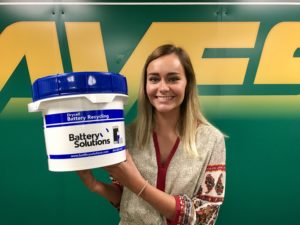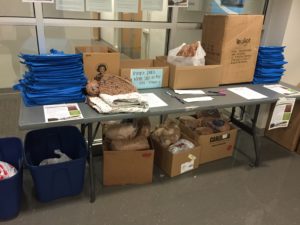2017, CINCINNATI, OHIO, USA
Claire Erny and Jacob Berry knew that residents in their hometown of Wyoming, Ohio yearned for a luscious and weed-free lawn. The dangers of trying to accomplish this goal can be serious and can contain a lot of chemicals and waste that may end up leaching into the waterways, affecting all aquatic life and drinking water. Jacob and Claire decided to come up with a recipe for an environmentally friendly and safe weed killer that is proven just as effective as other weed killers, but much more environmentally friendly, safer and a lot cheaper.
After looking at countless articles about natural weed killers, their teacher, Mr. Neimiller, informed them that he uses “vinegar and dawn dish soap” on his lawn at home, and it works wonders. To make a gallon of this weed killer, residents would need about one gallon of distilled white vinegar and two tablespoons of Dawn dish soap. Before deciding if they wanted to take on this project, Jacob and Claire needed try out this recipe for themselves. They soaked countless weeds with their homemade weed killer and approximately three hours later returned and the results were even better than expected.
The town of Wyoming has a smartphone app called ‘Next Door Wyoming’ people in the community can try to find babysitters, a cheap plumber, someone to walk their dog, pretty much anything. Jacob and Claire decided to make a post on Next Door Wyoming explaining their project and asking the citizens if they would like to try a bottle of the natural and homemade weed killer. Jacob and Claire expected to make about 10-15 bottles of weed killer, but received 40 requests in just 20 minutes. They quickly made extra bottles and dropped the weed killer off the next day and asked that residents email the results back to them.
Just one day after delivering the weed killer to all the residents, many emails came back with positive results and pictures. Not a single resident had a negative comment; some families even said they were going to stop using their old weed killer and start using the homemade version. Their favorite report came from a horticulturist from the Cincinnati gardens who said that her team was going to start using the homemade weed killer. They were able to book the Civic Center for late May (about a month after the final competition) and held an event to further educate the citizens on what a positive and major impact this has on our watershed, and only for $6.00.




 school and is always having to switch out old batteries in game systems. Through this experience she became aware of how many batteries were being tossed out. She started becoming more concerned about the problem as she researched the chemicals inside every single battery and began thinking about the impact these batteries have on our environment. As a senior at Sycamore High School she has been involved in Environmental Club, AP Environmental class, and engineering. With her background knowledge and interest she became motivated to help solve this problem.
school and is always having to switch out old batteries in game systems. Through this experience she became aware of how many batteries were being tossed out. She started becoming more concerned about the problem as she researched the chemicals inside every single battery and began thinking about the impact these batteries have on our environment. As a senior at Sycamore High School she has been involved in Environmental Club, AP Environmental class, and engineering. With her background knowledge and interest she became motivated to help solve this problem. project, Lexi put in place a battery-recycling program in all the schools within the Sycamore School District. These pails are located in the front offices of all schools and have begun overflowing with all the donations from community residents. She hopes recycling batteries becomes just as routine as recycling paper and plastic. With this permanent project Lexi hopes to educate her community on the simple actions they can take to make a big difference.
project, Lexi put in place a battery-recycling program in all the schools within the Sycamore School District. These pails are located in the front offices of all schools and have begun overflowing with all the donations from community residents. She hopes recycling batteries becomes just as routine as recycling paper and plastic. With this permanent project Lexi hopes to educate her community on the simple actions they can take to make a big difference. the environment. After kick-staring the education portion of their project, they started working on implementing phase one.
the environment. After kick-staring the education portion of their project, they started working on implementing phase one. Phase two started with a bag prepping party at which everyone folded, cut, and looped the plastic bags into balls of “yarn”. This ball of plastic yarn was then crocheted into sleeping mats that were donated to the homeless. They conducted significant amounts of research on how to properly crochet plastic sleeping mats, as well as the benefits of sleeping mats for those who are homeless. The mat weaving process was very time consuming and involved intricate work, so the students sought out the help of their school community for completing this part of our project.
Phase two started with a bag prepping party at which everyone folded, cut, and looped the plastic bags into balls of “yarn”. This ball of plastic yarn was then crocheted into sleeping mats that were donated to the homeless. They conducted significant amounts of research on how to properly crochet plastic sleeping mats, as well as the benefits of sleeping mats for those who are homeless. The mat weaving process was very time consuming and involved intricate work, so the students sought out the help of their school community for completing this part of our project.

 answers to the questions are recorded and a final report is give at the end of the game. Players can then use this score to identify how they can better help the bees in the watershed. The game can be found at:
answers to the questions are recorded and a final report is give at the end of the game. Players can then use this score to identify how they can better help the bees in the watershed. The game can be found at: 
 2017, Milliken, Colorado, USA
2017, Milliken, Colorado, USA n and budget focused as well. The students worked with the school district and installed three WR2 rain gauge sensors which have reduced water usage by 30-50%. They will be monitoring the water usage during 2017-2018 and reporting back to the school administration.
n and budget focused as well. The students worked with the school district and installed three WR2 rain gauge sensors which have reduced water usage by 30-50%. They will be monitoring the water usage during 2017-2018 and reporting back to the school administration.
 throughout the high traffic areas of the school. The materials from the new recycling bins are being collected by Waste Management. The company already has a recycling contract with the school, so it did not increase the overall expenditure for the district.
throughout the high traffic areas of the school. The materials from the new recycling bins are being collected by Waste Management. The company already has a recycling contract with the school, so it did not increase the overall expenditure for the district. 2017, Greeley, Colorado, USA
2017, Greeley, Colorado, USA Milkweed, Palmer Penstemon, Butterfly Milkweed, White Clover, Purple Coneflower, Mexican Hat, Yellow Coxie Flower, White Yarrow, and Black-Eyed Susan. In April, Riley organized a group of volunteers to clean the area, sow the seeds and install the insect boxes.
Milkweed, Palmer Penstemon, Butterfly Milkweed, White Clover, Purple Coneflower, Mexican Hat, Yellow Coxie Flower, White Yarrow, and Black-Eyed Susan. In April, Riley organized a group of volunteers to clean the area, sow the seeds and install the insect boxes. 2017 Berthoud, Colorado, USA
2017 Berthoud, Colorado, USA contaminates that are deposited there from the parking lot. Although the rain garden is a small site test, it can be expanded in the future by the school.
contaminates that are deposited there from the parking lot. Although the rain garden is a small site test, it can be expanded in the future by the school.